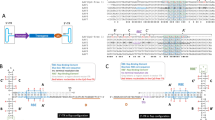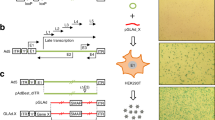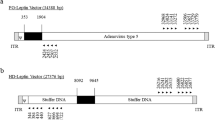Abstract
Fiber-substituted adenovirus (Ad) vectors containing fibers of Ad serotype 35 (AdF35) efficiently transduce a variety of human cells because their receptor, human CD46, is ubiquitously expressed on almost all nucleated cells. However, the ubiquitous expression of CD46 might lead to unexpected transduction in untargeted organs. In this study, we developed fiber-modified AdF35 vectors with an integrin-binding Arg-Gly-Asn (RGD) peptide incorporated into the FG, HI or IJ loop, which have been identified as important regions for binding to CD46. Incorporation of foreign peptides into these loops does not inhibit trimerization of the fibers. In CD46-negative cells, fiber-mutant AdF35 vectors containing an RGD peptide in the FG or HI loop showed 6- to 30-fold higher transduction efficiencies in an RGD-peptide-dependent manner than the unmodified AdF35 vectors. In contrast, in CD46-positive cells, insertion of foreign peptides markedly reduced the transduction efficiencies of the AdF35 vectors, indicating that insertion of foreign peptides significantly inhibits binding to CD46. In particular, CD46-mediated transduction was completely diminished by insertion of foreign peptides into the HI loop. Our findings indicate that HI loop is the most suitable domain to mediate a foreign peptide-dependent and CD46-independent transduction by incorporation of foreign peptides into the Ad35 fiber knob.
This is a preview of subscription content, access via your institution
Access options
Subscribe to this journal
Receive 12 print issues and online access
$259.00 per year
only $21.58 per issue
Buy this article
- Purchase on Springer Link
- Instant access to full article PDF
Prices may be subject to local taxes which are calculated during checkout






Similar content being viewed by others
References
Brody SL, Crystal RG . Adenovirus-mediated in vivo gene transfer. Ann NY Acad Sci 1994; 716: 90–103.
Kovesdi I, Brough DE, Bruder JT, Wickham TJ . Adenoviral vectors for gene transfer. Curr Opin Biotechnol 1997; 8: 583–589.
Benihoud K, Yeh P, Perricaudet M . Adenovirus vectors for gene delivery. Curr Opin Biotechnol 1999; 10: 440–447.
Cripe TP, Dunphy EJ, Holub AD, Saini A, Vasi NH, Mahller YY et al. Fiber knob modifications overcome low, heterogeneous expression of the coxsackievirus-adenovirus receptor that limits adenovirus gene transfer and oncolysis for human rhabdomyosarcoma cells. Cancer Res 2001; 61: 2953–2960.
Hemmi S, Geertsen R, Mezzacasa A, Peter I, Dummer R . The presence of human coxsackievirus and adenovirus receptor is associated with efficient adenovirus-mediated transgene expression in human melanoma cell cultures. Hum Gene Ther 1998; 9: 2363–2373.
Nalbantoglu J, Larochelle N, Wolf E, Karpati G, Lochmuller H, Holland PC . Muscle-specific overexpression of the adenovirus primary receptor CAR overcomes low efficiency of gene transfer to mature skeletal muscle. J Virol 2001; 75: 4276–4282.
Pickles RJ, McCarty D, Matsui H, Hart PJ, Randell SH, Boucher RC . Limited entry of adenovirus vectors into well-differentiated airway epithelium is responsible for inefficient gene transfer. J Virol 1998; 72: 6014–6023.
Zabner J, Freimuth P, Puga A, Fabrega A, Welsh MJ . Lack of high affinity fiber receptor activity explains the resistance of ciliated airway epithelia to adenovirus infection. J Clin Invest 1997; 100: 1144–1149.
Li Y, Pong RC, Bergelson JM, Hall MC, Sagalowsky AI, Tseng CP et al. Loss of adenoviral receptor expression in human bladder cancer cells: a potential impact on the efficacy of gene therapy. Cancer Res 1999; 59: 325–330.
Miller CR, Buchsbaum DJ, Reynolds PN, Douglas JT, Gillespie GY, Mayo MS et al. Differential susceptibility of primary and established human glioma cells to adenovirus infection: targeting via the epidermal growth factor receptor achieves fiber receptor-independent gene transfer. Cancer Res 1998; 58: 5738–5748.
Segerman A, Mei YF, Wadell G . Adenovirus types 11p and 35p show high binding efficiencies for committed hematopoietic cell lines and are infective to these cell lines. J Virol 2000; 74: 1457–1467.
Zhong L, Granelli-Piperno A, Choi Y, Steinman RM . Recombinant adenovirus is an efficient and non-perturbing genetic vector for human dendritic cells. Eur J Immunol 1999; 29: 964–972.
Mizuguchi H, Hayakawa T . Adenovirus vectors containing chimeric type 5 and type 35 fiber proteins exhibit altered and expanded tropism and increase the size limit of foreign genes. Gene 2002; 285: 69–77.
Shayakhmetov DM, Papayannopoulou T, Stamatoyannopoulos G, Lieber A . Efficient gene transfer into human CD34(+) cells by a retargeted adenovirus vector. J Virol 2000; 74: 2567–2583.
Gaggar A, Shayakhmetov DM, Lieber A . CD46 is a cellular receptor for group B adenoviruses. Nat Med 2003; 9: 1408–1412.
Segerman A, Atkinson JP, Marttila M, Dennerquist V, Wadell G, Arnberg N . Adenovirus type 11 uses CD46 as a cellular receptor. J Virol 2003; 77: 9183–9191.
Lu ZZ, Ni F, Hu ZB, Wang L, Wang H, Zhang QW et al. Efficient gene transfer into hematopoietic cells by a retargeting adenoviral vector system with a chimeric fiber of adenovirus serotype 5 and 11p. Exp Hematol 2006; 34: 1171–1182.
Takayama K, Reynolds PN, Short JJ, Kawakami Y, Adachi Y, Glasgow JN et al. A mosaic adenovirus possessing serotype Ad5 and serotype Ad3 knobs exhibits expanded tropism. Virology 2003; 309: 282–293.
DiPaolo N, Ni S, Gaggar A, Strauss R, Tuve S, Li ZY et al. Evaluation of adenovirus vectors containing serotype 35 fibers for vaccination. Mol Ther 2006; 13: 756–765.
Ni S, Bernt K, Gaggar A, Li ZY, Kiem HP, Lieber A . Evaluation of biodistribution and safety of adenovirus vectors containing group B fibers after intravenous injection into baboons. Hum Gene Ther 2005; 16: 664–677.
Sakurai F, Mizuguchi H, Yamaguchi T, Hayakawa T . Characterization of in vitro and in vivo gene transfer properties of adenovirus serotype 35 vector. Mol Ther 2003; 8: 813–821.
Koizumi N, Kawabata K, Sakurai F, Watanabe Y, Hayakawa T, Mizuguchi H . Modified adenoviral vectors ablated for coxsackievirus-adenovirus receptor, alphav integrin, and heparan sulfate binding reduce in vivo tissue transduction and toxicity. Hum Gene Ther 2006; 17: 264–279.
Smith TA, Idamakanti N, Rollence ML, Marshall-Neff J, Kim J, Mulgrew K et al. Adenovirus serotype 5 fiber shaft influences in vivo gene transfer in mice. Hum Gene Ther 2003; 14: 777–787.
Stecher H, Shayakhmetov DM, Stamatoyannopoulos G, Lieber A . A capsid-modified adenovirus vector devoid of all viral genes: assessment of transduction and toxicity in human hematopoietic cells. Mol Ther 2001; 4: 36–44.
Campos SK, Barry MA . Comparison of adenovirus fiber, protein IX, and hexon capsomeres as scaffolds for vector purification and cell targeting. Virology 2006; 349: 453–462.
Kurachi S, Koizumi N, Sakurai F, Kawabata K, Sakurai H, Nakagawa S et al. Characterization of capsid-modified adenovirus vectors containing heterologous peptides in the fiber knob, protein IX, or hexon. Gene Therapy 2007; 14: 266–274.
Wickham TJ, Tzeng E, Shears II LL, Roelvink PW, Li Y, Lee GM et al. Increased in vitro and in vivo gene transfer by adenovirus vectors containing chimeric fiber proteins. J Virol 1997; 71: 8221–8229.
Persson BD, Reiter DM, Marttila M, Mei YF, Casasnovas JM, Arnberg N et al. Adenovirus type 11 binding alters the conformation of its receptor CD46. Nat Struct Mol Biol 2007; 14: 164–166.
Durmort C, Stehlin C, Schoehn G, Mitraki A, Drouet E, Cusack S et al. Structure of the fiber head of Ad3, a non-CAR-binding serotype of adenovirus. Virology 2001; 285: 302–312.
Pache L, Venkataraman S, Reddy VS, Nemerow GR . Structural variations in species B adenovirus fibers impact CD46 association. J Virol 2008; 82: 7923–7931.
Wang H, Liaw YC, Stone D, Kalyuzhniy O, Amiraslanov I, Tuve S et al. Identification of CD46 binding sites within the adenovirus serotype 35 fiber knob. J Virol 2007; 81: 12785–12792.
Pache L, Venkataraman S, Nemerow GR, Reddy VS . Conservation of fiber structure and CD46 usage by subgroup B2 adenoviruses. Virology 2008; 375: 573–579.
Wang H, Liu Y, Li Z, Tuve S, Stone D, Kalyushniy O et al. In vitro and in vivo properties of adenovirus vectors with increased affinity to CD46. J Virol 2008; 82: 10567–10579.
Mizuguchi H, Koizumi N, Hosono T, Utoguchi N, Watanabe Y, Kay MA et al. A simplified system for constructing recombinant adenoviral vectors containing heterologous peptides in the HI loop of their fiber knob. Gene Therapy 2001; 8: 730–735.
Koizumi N, Mizuguchi H, Utoguchi N, Watanabe Y, Hayakawa T . Generation of fiber-modified adenovirus vectors containing heterologous peptides in both the HI loop and C terminus of the fiber knob. J Gene Med 2003; 5: 267–276.
Arap W, Pasqualini R, Ruoslahti E . Cancer treatment by targeted drug delivery to tumor vasculature in a mouse model. Science 1998; 279: 377–380.
Pasqualini R, Koivunen E, Ruoslahti E . Alpha v integrins as receptors for tumor targeting by circulating ligands. Nat Biotechnol 1997; 15: 542–546.
Koizumi N, Mizuguchi H, Sakurai F, Yamaguchi T, Watanabe Y, Hayakawa T . Reduction of natural adenovirus tropism to mouse liver by fiber-shaft exchange in combination with both CAR- and alphav integrin-binding ablation. J Virol 2003; 77: 13062–13072.
Maizel Jr JV, White DO, Scharff MD . The polypeptides of adenovirus. I. Evidence for multiple protein components in the virion and a comparison of types 2, 7A, and 12. Virology 1968; 36: 115–125.
Shayakhmetov DM, Lieber A . Dependence of adenovirus infectivity on length of the fiber shaft domain. J Virol 2000; 74: 10274–10286.
Koizumi N, Mizuguchi H, Hosono T, Ishii-Watabe A, Uchida E, Utoguchi N et al. Efficient gene transfer by fiber-mutant adenoviral vectors containing RGD peptide. Biochim Biophys Acta 2001; 1568: 13–20.
Sakurai F, Murakami S, Kawabata K, Okada N, Yamamoto A, Seya T et al. The short consensus repeats 1 and 2, not the cytoplasmic domain, of human CD46 are crucial for infection of subgroup B adenovirus serotype 35. J Control Release 2006; 113: 271–278.
Buchholz CJ, Koller D, Devaux P, Mumenthaler C, Schneider-Schaulies J, Braun W et al. Mapping of the primary binding site of measles virus to its receptor CD46. J Biol Chem 1997; 272: 22072–22079.
Gustafsson DJ, Segerman A, Lindman K, Mei YF, Wadell G . The Arg279Gln [corrected] substitution in the adenovirus type 11p (Ad11p) fiber knob abolishes EDTA-resistant binding to A549 and CHO-CD46 cells, converting the phenotype to that of Ad7p. J Virol 2006; 80: 1897–1905.
Fleischli C, Sirena D, Lesage G, Havenga MJ, Cattaneo R, Greber UF et al. Species B adenovirus serotypes 3, 7, 11 and 35 share similar binding sites on the membrane cofactor protein CD46 receptor. J Gen Virol 2007; 88: 2925–2934.
Borovjagin AV, Krendelchtchikov A, Ramesh N, Yu DC, Douglas JT, Curiel DT . Complex mosaicism is a novel approach to infectivity enhancement of adenovirus type 5-based vectors. Cancer Gene Ther 2005; 12: 475–486.
Tyler MA, Ulasov IV, Borovjagin A, Sonabend AM, Khramtsov A, Han Y et al. Enhanced transduction of malignant glioma with a double targeted Ad5/3-RGD fiber-modified adenovirus. Mol Cancer Ther 2006; 5: 2408–2416.
Maisner A, Zimmer G, Liszewski MK, Lublin DM, Atkinson JP, Herrler G . Membrane cofactor protein (CD46) is a basolateral protein that is not endocytosed. Importance of the tetrapeptide FTSL at the carboxyl terminus. J Biol Chem 1997; 272: 20793–20799.
Miwa T, Nonaka M, Okada N, Wakana S, Shiroishi T, Okada H . Molecular cloning of rat and mouse membrane cofactor protein (MCP, CD46): preferential expression in testis and close linkage between the mouse Mcp and Cr2 genes on distal chromosome 1. Immunogenetics 1998; 48: 363–371.
Sakurai F, Mizuguchi H, Hayakawa T . Efficient gene transfer into human CD34+ cells by an adenovirus type 35 vector. Gene Therapy 2003; 10: 1041–1048.
Seshidhar Reddy P, Ganesh S, Limbach MP, Brann T, Pinkstaff A, Kaloss M et al. Development of adenovirus serotype 35 as a gene transfer vector. Virology 2003; 311: 384–393.
Sumida SM, Truitt DM, Lemckert AA, Vogels R, Custers JH, Addo MM et al. Neutralizing antibodies to adenovirus serotype 5 vaccine vectors are directed primarily against the adenovirus hexon protein. J Immunol 2005; 174: 7179–7185.
Nwanegbo E, Vardas E, Gao W, Whittle H, Sun H, Rowe D et al. Prevalence of neutralizing antibodies to adenoviral serotypes 5 and 35 in the adult populations of The Gambia, South Africa, and the United States. Clin Diagn Lab Immunol 2004; 11: 351–357.
Hamilton MM, Byrnes GA, Gall JG, Brough DE, King CR, Wei LL . Alternate serotype adenovector provides long-term therapeutic gene expression in the eye. Mol Vis 2008; 14: 2535–2546.
Hynes RO . Integrins: bidirectional, allosteric signaling machines. Cell 2002; 110: 673–687.
Denby L, Work LM, Seggern DJ, Wu E, McVey JH, Nicklin SA et al. Development of renal-targeted vectors through combined in vivo phage display and capsid engineering of adenoviral fibers from serotype 19p. Mol Ther 2007; 15: 1647–1654.
Acknowledgements
This work was supported in part by grants for Research on Publicly Essential Drugs and Medical Devices of The Japan Health Sciences Foundation, and The Uehara Memorial Foundation.
Author information
Authors and Affiliations
Corresponding author
Rights and permissions
About this article
Cite this article
Matsui, H., Sakurai, F., Kurachi, S. et al. Development of fiber-substituted adenovirus vectors containing foreign peptides in the adenovirus serotype 35 fiber knob. Gene Ther 16, 1050–1057 (2009). https://doi.org/10.1038/gt.2009.65
Received:
Revised:
Accepted:
Published:
Issue Date:
DOI: https://doi.org/10.1038/gt.2009.65



